Trane Technologies Bundle
How did a plumbing business become a climate control giant?
Journey through the remarkable Trane Technologies SWOT Analysis and discover how a family plumbing business transformed into a global leader in climate innovation. From its humble beginnings in 1885, Trane Technologies has consistently pushed boundaries, achieving key milestones and strategic shifts. Uncover the pivotal moments that shaped this HVAC industry titan and its enduring legacy.
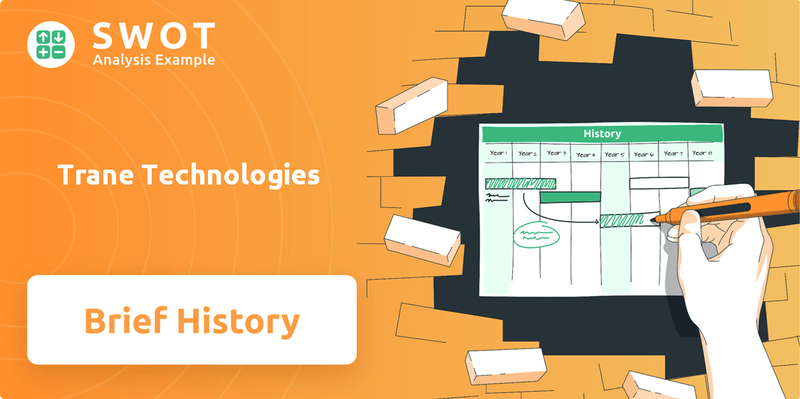
The Trane company's story is one of continuous adaptation and innovation within the climate control sector. Tracing the brief history of Trane Technologies reveals a company that has not only survived but thrived by anticipating market needs and embracing technological advancements. The company's evolution, including the significant merger with Ingersoll Rand, showcases its ability to adapt to changing market dynamics and solidify its position in the HVAC industry. Understanding the early days of Trane provides crucial context for appreciating its current market share and future prospects.
What is the Trane Technologies Founding Story?
The story of Trane Technologies, a leader in climate control solutions, began in 1885. It all started with James Trane, a Norwegian immigrant, who set up a plumbing and pipe-fitting shop in La Crosse, Wisconsin. This shop laid the groundwork for what would become a global enterprise in the HVAC industry.
James Trane's vision extended beyond basic plumbing. He saw the potential to improve heating systems and designed a new, more efficient low-pressure steam heating system, known as Trane vapor heating. His son, Reuben Trane, a mechanical engineer, joined the firm in 1910. Reuben's engineering expertise was critical to the company's evolution, and he played a key role in its formal incorporation as The Trane Company in 1913.
The early days of Trane Technologies were marked by innovation and a focus on improving existing technologies. The company's initial business model was centered on manufacturing and selling these innovative heating solutions. Details on initial funding sources are not readily available, but the company started as a family business, suggesting early bootstrapping or family investments. The company's name, 'Trane,' directly reflects the family behind its establishment and early innovations.
The early years of Trane were defined by key innovations and strategic shifts that set the stage for its future growth.
- 1885: James Trane establishes a plumbing and pipe-fitting shop, the precursor to the company.
- 1910: Reuben Trane, a mechanical engineer, joins the firm, bringing crucial technical expertise.
- 1913: The company is formally incorporated as The Trane Company, marking a significant step in its development.
- 1916: The company shifts its primary focus to manufacturing heating products.
- 1923: Reuben Trane invents the convector radiator, a lighter and more efficient heating solution, which becomes a major success.
By 1916, the company had fully transitioned to manufacturing heating products. A significant innovation came in 1923 when Reuben Trane invented the convector radiator. This invention was a lighter and more efficient alternative to the bulky cast-iron radiators of the time. This innovation was a major success and marked a turning point for the company. The company's focus on innovation and efficiency in its early years laid the foundation for its later expansion and success in the climate control market. For more information about the company's customer base, you can read about the Target Market of Trane Technologies.
Trane Technologies SWOT Analysis
- Complete SWOT Breakdown
- Fully Customizable
- Editable in Excel & Word
- Professional Formatting
- Investor-Ready Format
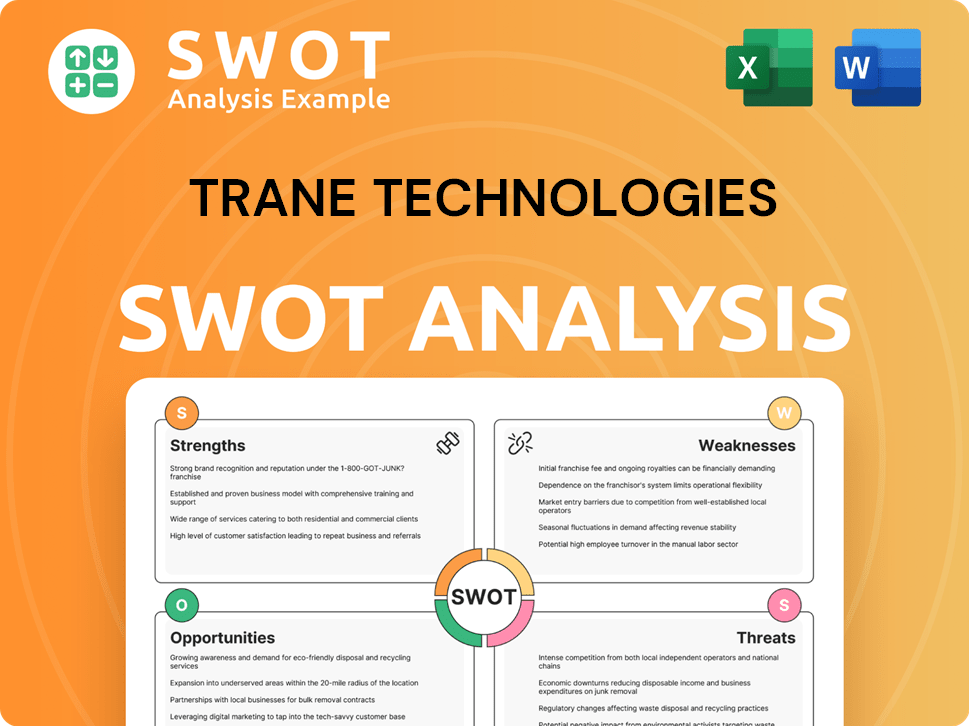
What Drove the Early Growth of Trane Technologies?
The early growth of Trane Technologies focused on expanding its heating product line, but a significant shift occurred with its entry into the air conditioning market. This expansion included the development of innovative products that revolutionized how large buildings managed their climate control. Over the years, Trane broadened its offerings and market reach through strategic acquisitions and innovations. This shaped the Trane Technologies company timeline.
In 1931, a pivotal moment in Trane history was the patenting of its first air conditioning unit. This marked its entry into the emerging HVAC industry. Following this, the 'Turbovac' water chiller was developed, significantly improving large-building air conditioning systems. These innovations helped establish Trane as a key player in the climate control sector.
The late 1970s saw Trane acquire Sentinel Electronics, broadening its portfolio. In 1982, the acquisition of General Electric's Central Air Conditioning Division further expanded its residential and energy management solutions. These moves were crucial for Trane Technologies acquisition history. In 1984, American Standard Companies, Inc. acquired Trane, further expanding its market presence.
A major transition occurred in June 2008 when Trane was acquired by Ingersoll Rand. This merger transformed Trane into a multi-brand commercial manufacturer serving diverse global markets. This acquisition has been a critical factor in Trane Technologies's global reach. The merger with Ingersoll Rand significantly impacted the company's operations and market position.
Throughout this period, Trane established a robust global distribution network. It continued to invest heavily in research and development, solidifying its reputation for reliability and innovation. This commitment to innovation is a key aspect of Trane Technologies's success. For more insights, consider the Competitors Landscape of Trane Technologies.
Trane Technologies PESTLE Analysis
- Covers All 6 PESTLE Categories
- No Research Needed – Save Hours of Work
- Built by Experts, Trusted by Consultants
- Instant Download, Ready to Use
- 100% Editable, Fully Customizable
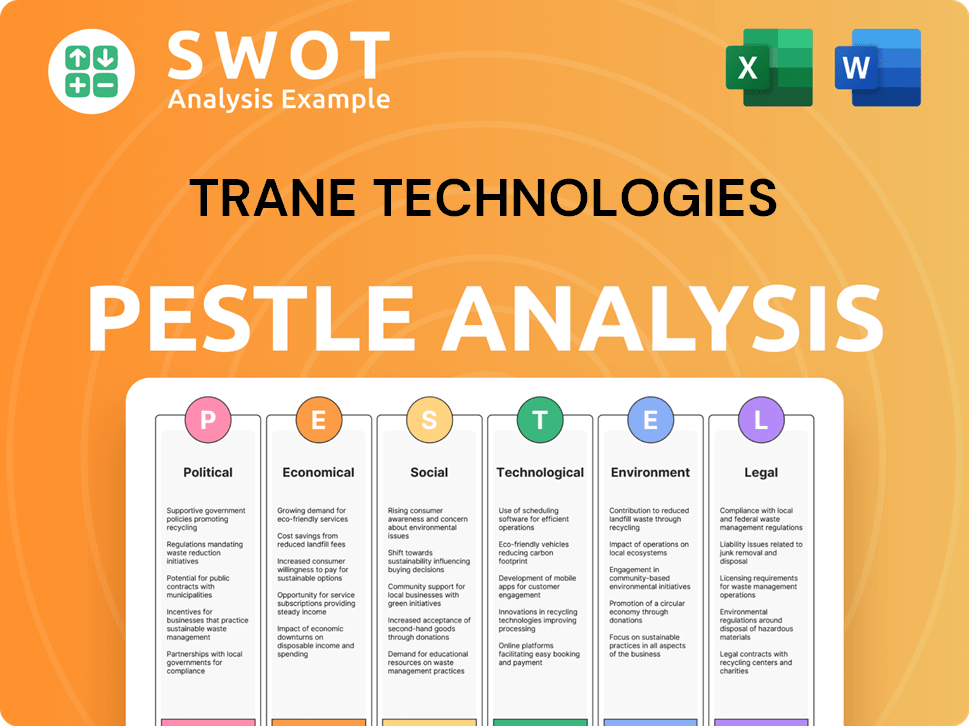
What are the key Milestones in Trane Technologies history?
The Trane Technologies has a rich Trane history marked by significant achievements and strategic shifts. From its early days to its current standing in the HVAC industry, the company has consistently adapted and innovated to meet market demands and overcome challenges, solidifying its position as a leader in climate control solutions. The Trane Technologies company journey reflects a commitment to technological advancement, sustainability, and financial performance.
| Year | Milestone |
|---|---|
| 1931 | Development of the first air conditioning unit, a pivotal moment in the company's early days. |
| 1930s | Introduction of the Turbovac water chiller, revolutionizing large-building air conditioning. |
| 2024 | Launched 190 new products, including a significant portfolio refresh with lower global warming potential (GWP) refrigerants. |
| 2024 | Committed to reducing embodied carbon in its products by 40% by 2030, an industry-first initiative. |
Trane Technologies has consistently focused on innovation, launching numerous products to meet evolving market needs. The company's commitment to product evolution is evident in its continuous investment in research and development, leading to advancements in efficiency and sustainability.
The Turbovac water chiller was a groundbreaking innovation, changing the approach to large-building air conditioning. This innovation significantly improved the efficiency and effectiveness of cooling systems in commercial and industrial settings.
In 2024, Trane Technologies refreshed its product portfolio with refrigerants that have lower global warming potential (GWP). This strategic move aligns with the company's sustainability goals and responds to increasing environmental regulations.
Trane Technologies invests in digital and automation technologies to improve efficiency and customer solutions. These technologies enhance operational performance and support the development of smart, connected systems.
The company's focus on sustainable products, including those with reduced carbon footprints, is a key aspect of its innovation strategy. This focus helps customers achieve their sustainability goals while meeting regulatory requirements.
Despite its successes, Trane Technologies faces challenges common in the HVAC industry, including economic cycles and fluctuating raw material costs. The company's ability to navigate these challenges, coupled with its commitment to innovation, has allowed it to maintain strong financial performance.
Demand for HVAC systems can be affected by economic downturns, impacting Trane Technologies' sales. The company's strategic investments in diverse markets and product offerings help mitigate these risks.
Fluctuations in raw material costs can affect profitability, requiring Trane Technologies to manage its supply chain and pricing strategies. The company uses hedging and other financial tools to mitigate these impacts.
The company operates in a complex regulatory environment, with evolving standards for energy efficiency and refrigerant use. Trane Technologies proactively adapts to these changes through innovation and compliance efforts.
The HVAC industry is highly competitive, requiring Trane Technologies to continuously innovate and differentiate its offerings. The company's focus on customer needs and technological advancements helps it maintain a competitive edge.
Tariffs and trade regulations can increase costs, as management estimates tariffs could add $250 million-$275 million of incremental costs in 2025. The company mitigates these through pricing actions and supply chain optimization.
For more insights into the company's values and objectives, you can read about the Mission, Vision & Core Values of Trane Technologies.
Trane Technologies Business Model Canvas
- Complete 9-Block Business Model Canvas
- Effortlessly Communicate Your Business Strategy
- Investor-Ready BMC Format
- 100% Editable and Customizable
- Clear and Structured Layout
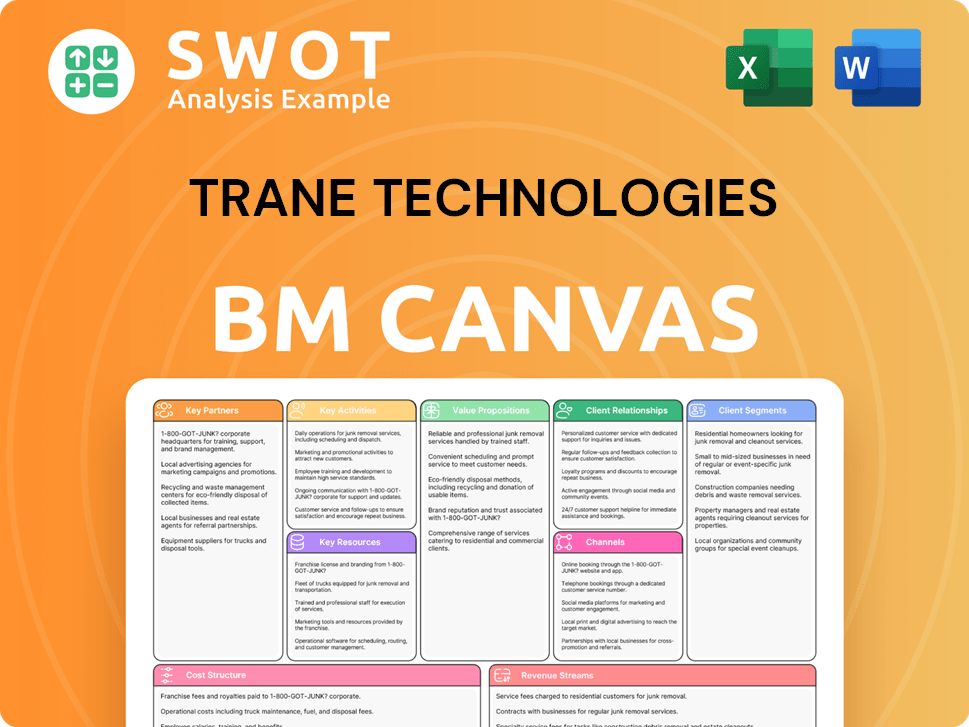
What is the Timeline of Key Events for Trane Technologies?
The Trane Technologies company's journey, marked by innovation and strategic shifts, began in 1885 with James Trane's plumbing shop. The company evolved, incorporating in 1913 and developing key products such as the convector radiator in 1923 and its first air conditioning unit in 1931. Through acquisitions, including American Standard in 1984 and Thermo King in 1997, and a spin-off from Ingersoll Rand in 2020, Trane Technologies has grown into a major player in the climate control and HVAC industry.
| Year | Key Event |
|---|---|
| 1885 | James Trane opens a plumbing and pipe-fitting shop in La Crosse, Wisconsin, marking the beginning of the company's history. |
| 1913 | The Trane Company is formally incorporated by James and Reuben Trane, solidifying its presence in the market. |
| 1923 | Reuben Trane invents the convector radiator, showcasing early innovation in heating technology. |
| 1931 | Trane develops its first air conditioning unit, expanding its focus to include climate control solutions. |
| 1984 | American Standard Companies, Inc. acquires The Trane Company, leading to significant changes in ownership. |
| 1997 | Thermo King, a key brand in transport refrigeration, is acquired, broadening the company's portfolio. |
| 2007 | American Standard Companies divides, and the HVAC business is renamed Trane, focusing on climate solutions. |
| 2008 | Trane is acquired by Ingersoll Rand, integrating it into a larger industrial group. |
| 2020 | The industrial segment of Ingersoll Rand is spun off, and the climate segment is renamed Trane Technologies, highlighting its climate-focused strategy. |
| 2024 | Reported revenues reached $19.8 billion, a 12% increase year-over-year, and the company launched 190 new products. |
Trane Technologies anticipates continued growth, driven by global trends in urbanization and energy efficiency. The company is strategically aligned with long-term trends like decarbonization and electrification. They expect to perform strongly in 2025, aiming for the high end of their revenue and earnings per share (EPS) guidance.
For 2025, Trane Technologies projects revenue growth of roughly 6.5% to 7.5%. They also anticipate adjusted EPS to be between $12.70 and $12.90. The commercial HVAC products and services are expected to grow at a mid-single-digit percentage. The company has a substantial backlog, which provides strong visibility for future revenue.
Trane Technologies is committed to reducing its environmental impact. They have reduced customer carbon emissions by 237 million metric tons since the 2019 baseline. The company has also reduced operational emissions by 44%. Their long-term goal is net-zero emissions by 2050, with targets validated by the Science Based Targets Initiative (SBTi).
The company is investing in a state-of-the-art training facility for HVAC service technicians, scheduled to open in 2025. This investment supports their long-term strategy and commitment to innovation. These investments support the company's focus on creating sustainable building solutions and enhancing its market position in the HVAC industry.
Trane Technologies Porter's Five Forces Analysis
- Covers All 5 Competitive Forces in Detail
- Structured for Consultants, Students, and Founders
- 100% Editable in Microsoft Word & Excel
- Instant Digital Download – Use Immediately
- Compatible with Mac & PC – Fully Unlocked
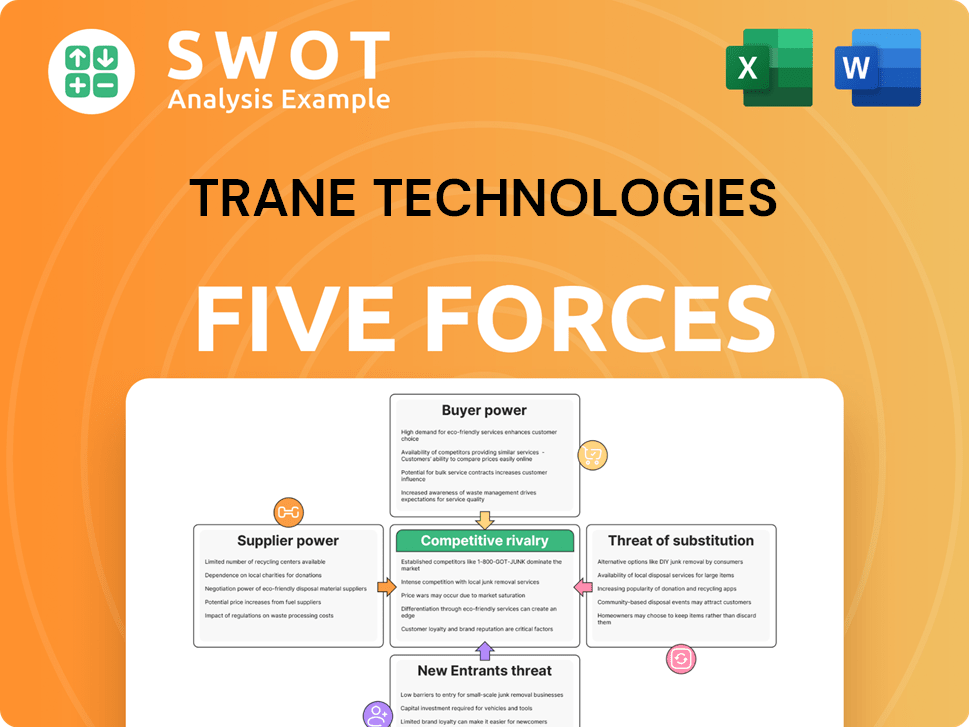
Related Blogs
- What is Competitive Landscape of Trane Technologies Company?
- What is Growth Strategy and Future Prospects of Trane Technologies Company?
- How Does Trane Technologies Company Work?
- What is Sales and Marketing Strategy of Trane Technologies Company?
- What is Brief History of Trane Technologies Company?
- Who Owns Trane Technologies Company?
- What is Customer Demographics and Target Market of Trane Technologies Company?
Disclaimer
All information, articles, and product details provided on this website are for general informational and educational purposes only. We do not claim any ownership over, nor do we intend to infringe upon, any trademarks, copyrights, logos, brand names, or other intellectual property mentioned or depicted on this site. Such intellectual property remains the property of its respective owners, and any references here are made solely for identification or informational purposes, without implying any affiliation, endorsement, or partnership.
We make no representations or warranties, express or implied, regarding the accuracy, completeness, or suitability of any content or products presented. Nothing on this website should be construed as legal, tax, investment, financial, medical, or other professional advice. In addition, no part of this site—including articles or product references—constitutes a solicitation, recommendation, endorsement, advertisement, or offer to buy or sell any securities, franchises, or other financial instruments, particularly in jurisdictions where such activity would be unlawful.
All content is of a general nature and may not address the specific circumstances of any individual or entity. It is not a substitute for professional advice or services. Any actions you take based on the information provided here are strictly at your own risk. You accept full responsibility for any decisions or outcomes arising from your use of this website and agree to release us from any liability in connection with your use of, or reliance upon, the content or products found herein.